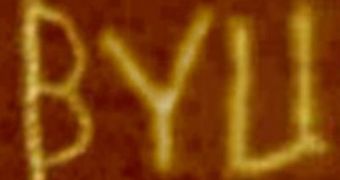Manipulating DNA strands individually and precisely is one of the most sought-after technologies in science today, simply because this would open up tremendous, new research possibilities in fields ranging from medicine to computing. In the latter, circuits made from nanomaterials combined with DNA could lead to amazing advancements in processing power, as well as to reduced sizes for electronic components. Experts at the Brigham Young University are at the forefront of learning to manipulate DNA, as they recently managed to create a custom text of the university's name, using specifically tailored DNA molecules.
They essentially shaped and customized fragments of the nucleic acid in such a manner that the end-product spelled “BYU.” Their report on the accomplishment, which appears in the aptly named scientific journal Nano Letters, also reveals that the letters were about 100 nanometers in size each, or roughly one thousandth of the width of a human hair. While the achievement may not seem like much in the eyes of the uninitiated, it brings in fact the research team a huge step closer to developing DNA-based circuit shapes, to which other nanomaterials could be attached in the future.
This would essentially result in tiny and inexpensive computer chips. The field of DNA origami, as manipulating the nucleic acid is called, is relatively new. Only a few years ago did a Caltech computer scientist weave the first strands of DNA into smiley faces, setting the tone for a large number of studies and investigations into how this could be done for actual scientific applications.
Until now, the approach to constructing shapes out of DNA has been to locate viruses and other microorganisms whose nucleic acid strands were of the desired length. This was pretty much like constructing a cabin out of available trees, without the use of a saw. In the BYU approach, DNA is replicated, so that it makes strands of precisely the required length.
“I was blown away when the students were able to make B's. Right angle shapes, that's one thing. But to make something with curves and multiple intersections, I thought 'Wow, that is really cool,'” BYU Chemistry Professor Adam Woolley, the author of the paper, and the leader of the research team, says. Undergraduate student Jeffrey Ashton and BYU students Elisabeth Pound and Hector Becerril have also contributed to the investigation.
“This very quickly went from the initial design of a simple rectangle shape to more sophisticated branching. It's a testament to the quality of graduate students and undergraduates we have here in our department and at BYU in general,” the expert concludes. The work was supported by a $1-million grant from the US National Science Foundation (NSF).

 14 DAY TRIAL //
14 DAY TRIAL //